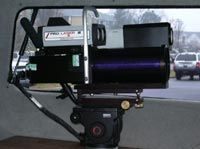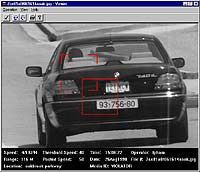 The Charlotte-Mecklenburg Police Department (CMPD) in Charlotte, North Carolina had a total of 27,000 crashes during 2003. Speed was the primary factor in 26 of the 58 fatal crashes during that year and it was also the primary factor in more than 25% of all vehicle crashes. This crash rate was not only placing a resource drain on police, fire and medical resources but it was estimated that speed-related crashes were costing the community in excess of $476 million annually. Traditional methods of enforcing speed limits were not keeping pace with the magnitude of the problem. When the department learned about an automated speed enforcement program in Arizona, they wanted to adopt something similar to decrease speeds and collisions. Charlotte-Mecklenburg looked at several vendors who proposed using radar, but “We wanted to use laser because the issues with radar are the co-sign effect that can produce inaccurate speed readings and it’s not target specific,” said Charlotte-Mecklenburg Detective, Charlie Brown.
The Charlotte-Mecklenburg Police Department (CMPD) in Charlotte, North Carolina had a total of 27,000 crashes during 2003. Speed was the primary factor in 26 of the 58 fatal crashes during that year and it was also the primary factor in more than 25% of all vehicle crashes. This crash rate was not only placing a resource drain on police, fire and medical resources but it was estimated that speed-related crashes were costing the community in excess of $476 million annually. Traditional methods of enforcing speed limits were not keeping pace with the magnitude of the problem. When the department learned about an automated speed enforcement program in Arizona, they wanted to adopt something similar to decrease speeds and collisions. Charlotte-Mecklenburg looked at several vendors who proposed using radar, but “We wanted to use laser because the issues with radar are the co-sign effect that can produce inaccurate speed readings and it’s not target specific,” said Charlotte-Mecklenburg Detective, Charlie Brown.
In August, 2004, after releasing a request for proposal, the department chose the Kustom Signals/Peek Traffic Corporation team as the vendor of choice to help them with their two-year pilot project to reduce speeding, number of accidents and to free up officer’s time. Kustom Signals provided its Digital Traffic Monitoring System (DTMS) which consists of automatic laser-based digital photo speed enforcement and Peek to manage the processing and mailing of citations, inquiries and a website where citizens can view their violation information.
 The DTMS can be operated as an attended or unattended system, 24-hours a day, regardless of weather conditions. Digital violator images are captured with laser speed measurement accuracy. Each image contains photo of vehicle, the vehicle’s speed and distance, the date, time, location, the threshold speed, the posted speed limit and the laser’s aiming reticle. Long-range performance permits it to be mounted in overpasses and covert tunnel installations. The DTMS also offers the ability to select individual lanes from multi-lane roads and eliminates obstruction of passing vehicles from non-targeted lanes.
The DTMS can be operated as an attended or unattended system, 24-hours a day, regardless of weather conditions. Digital violator images are captured with laser speed measurement accuracy. Each image contains photo of vehicle, the vehicle’s speed and distance, the date, time, location, the threshold speed, the posted speed limit and the laser’s aiming reticle. Long-range performance permits it to be mounted in overpasses and covert tunnel installations. The DTMS also offers the ability to select individual lanes from multi-lane roads and eliminates obstruction of passing vehicles from non-targeted lanes.
Charlotte-Mecklenburg currently has three DTMS located in vans that are operated and monitored by certified officers every day from 7 a.m. to 11 p.m. and are deployed along 14 high-crash corridors. Before implementing this project, the department spent hundreds of thousands of dollars publicizing their efforts including street signs, billboards, public service announcements and an insert in the city’s water bills. Since the installation of the DTMS units, Detective Brown said that the public is reporting a general reduction in motorists’ speeds in these high-speed/crash corridors.
“With photo enforcement technology you can go from the stone age to the space age in one leap,” said Captain Haggist of CMPD. “Even with your best trained and equipped officer in the most optimal situation, you may only be able to issue citations every 30 minutes, but with photo enforcement, you can detect a violation and issue a citation every 1/2 second.”
“In 2004, CMPD saw an overall decrease of 33% in fatalities and data through the end of October showed an overall decrease of 8% in crashes,” said Haggist.
For nearly 40 years, Kustom Signals, Inc. has been a world leader in the design, manufacture and sale of in-car video, radar, laser, and speed monitoring/message sign trailers.


